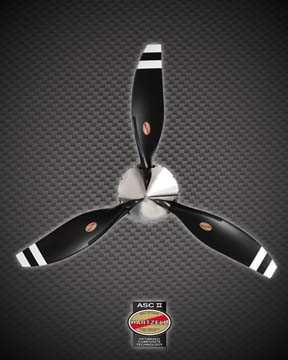Mon, Jul 24, 2006
Developed Especially For GA
 Hartzell Propeller Inc. gave
Aero-News a heads up on the news it has received FAA certification
for its new ASC-II second-generation Advanced Structural Composite
propeller system. Hartzell says the ASC-II is the first FAA
certified advanced structural composite propeller developed
specifically for the general aviation market.
Hartzell Propeller Inc. gave
Aero-News a heads up on the news it has received FAA certification
for its new ASC-II second-generation Advanced Structural Composite
propeller system. Hartzell says the ASC-II is the first FAA
certified advanced structural composite propeller developed
specifically for the general aviation market.
The ASC-II is billed as the result of the company's nearly 30
year experience in the design and manufacture of advanced
structural composite propellers. Hartzell calls the ASC-II an
'optimized' design, mated to a proprietary, Hartzell-developed
manufacturing process.
The result is an advanced structural composite propeller that
delivers all of the advantages provided by Hartzell's first
generation of composite propellers -- low weight, low inertia, and
low life cycle costs -- while minimizing the major disadvantage:
the high cost manufacturing process.
The Hartzell ASC-II consists of a composite monocoque structure
composed of carbon/Kevlar laminate, integrated into a co-molded
stainless steel shank. The outboard half of the leading edge is
protected with a co-molded electroformed nickel erosion
shield. Aluminum mesh is embedded into the laminate for
lightning protection.
Hartzell says the new design offers numerous benefits to
aircraft owners, including:
- Lighter weight - ASC-II blades weigh 30% less per blade
than comparable metal blades, providing greater useful load and
moving the aircraft center of gravity away from the propeller,
often creating more versatile loading capability.
- Lower inertia - Propellers with ASC-II blades provide
dramatic reductions in inertia, which is VERY important for
aerobatic aircraft to minimize the gyroscopic effects of the
propeller. Often, it also means lower vibration and smoother
operation for GA aircraft.
- More durable - Properly maintained, the Hartzell ASC-II
blade will never require replacement because, unlike a metal blade,
its surface can be restored.
- Higher performance - Typically composite blades can not
quite match the performance of metal blades, since metal blades can
be produced with the thin airfoil sections needed for maximum
performance. However, Hartzell says the use of carbon, in
combination with Hartzell's specialized manufacturing process,
yields a strong, yet thin, monocoque structure that permits the use
of thinner airfoil sections at the blade tips and performance
comparable to metal.
- Higher strength - The Hartzell ASC-II uses carbon and
Kevlar materials to make the structural part of the blade, creating
an extremely high strength advanced structural composite blade that
is stronger than other composite propeller blades.
- Proven design - Passing the rigorous certification
process provides assurance that the Hartzell ASC-II design is well
proven. As the only certified advanced structural composite
propeller in the GA market, the Hartzell ASC-II has lived through a
simulated encounter with a four pound bird at rotation, taken a
direct hit of 200,000 amps of electricity to prove that it can
survive an encounter with lightning, and withstood a direct pull of
132,000 pounds reaching the limit of the test fixture without
failing (6.8 times the normal Cf load) to demonstrate a safety
margin in the event of an engine overspeed.
Hartzell also states a major launch customer for the first
Hartzell ASC-II propeller model will be announced at EAA AirVenture
Oshkosh 2006.
More News
Terminal Radar Service Area Airspace surrounding designated airports wherein ATC provides radar vectoring, sequencing, and separation on a full-time basis for all IFR and participa>[...]
Aero Linx: Utah Back Country Pilots Association (UBCP) Through the sharing experiences, the UBCP has built upon a foundation of safe operating practices in some of the most challen>[...]
From 2010 (YouTube Edition): Imagine... Be The Change... Inspire FROM 2010: One of the more unusual phone calls I have ever received occurred a few years ago... from Anousheh Ansar>[...]
(Pilot) Felt A Shudder And Heard The Engine Sounding Differently, Followed By The Engine Chip Detector Light On April 14, 2025, about 1800 Pacific daylight time, a Bell 206B, N1667>[...]
Also: AMA Names Tyler Dobbs, More Falcon 9 Ops, Firefly Launch Unsuccessful, Autonomous F-16s The Air Force has begun ground testing a future uncrewed jet design in a milestone tow>[...]
 ANN's Daily Aero-Term (05.07.25): Terminal Radar Service Area
ANN's Daily Aero-Term (05.07.25): Terminal Radar Service Area ANN's Daily Aero-Linx (05.07.25)
ANN's Daily Aero-Linx (05.07.25) Classic Aero-TV: Anousheh Ansari -- The Woman Behind The Prize
Classic Aero-TV: Anousheh Ansari -- The Woman Behind The Prize NTSB Prelim: Bell 206B
NTSB Prelim: Bell 206B Airborne-NextGen 05.06.25: AF Uncrewed Fighters, Drones v Planes, Joby Crew Test
Airborne-NextGen 05.06.25: AF Uncrewed Fighters, Drones v Planes, Joby Crew Test



